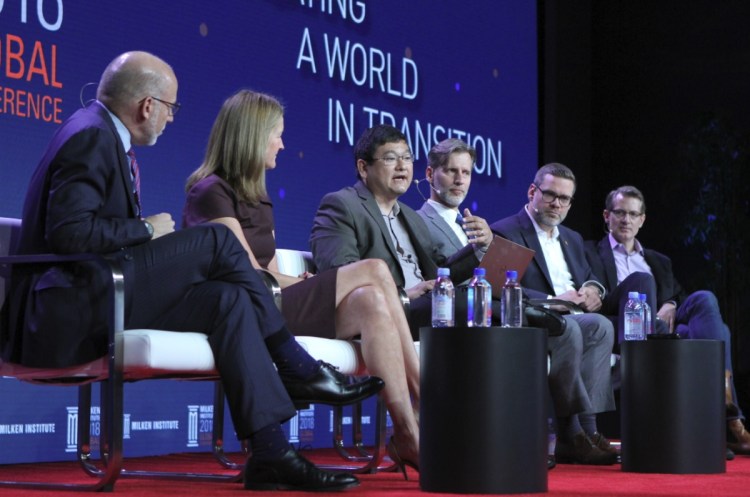Last week was a big moment for esports as investors gathered at the Milken Global conference to listen to a panel I moderated on how fast the esports phenomenon — which is two decades plus in the making — has begun to grow.
No longer are we arguing about whether people will watch someone else place games. The discussion is now about how many hundreds of millions of people are doing it. The fact that this discussion was happening at the Milken event in Beverly Hills, California, shows that big money and the super rich have descended on the esports explosion.
Global esports revenues are expected grow 38 percent to $906 million in 2018 and further grow to $1.65 billion by 2021, according to a new annual report on esports by market researcher Newzoo. Esports is less than 1 percent of the revenue of the $137.9 billion global games business. But it is the shiny new thing. I’m writing stories every week about esports, much like a year or two ago I was writing every week about virtual reality investments and startups.
My panel included Kent Wakeford, cofounder of KSV Esports (now known as Gen.G); Nate Nanzer, commissioner of the Overwatch League at Activision Blizzard; Ramon Hermann, director of esports at Tencent America; Ann Hand, CEO of Super League Gaming; and Steve Cohen, executive vice president at The Anschutz Corporation and chief strategy officer at Anschutz Entertainment Group.
June 5th: The AI Audit in NYC
Join us next week in NYC to engage with top executive leaders, delving into strategies for auditing AI models to ensure fairness, optimal performance, and ethical compliance across diverse organizations. Secure your attendance for this exclusive invite-only event.
Our discussion ranged from the short life of video game esports as new games such as battle royale title Fortnite knocks out older games, to the investment that property owners are making in esports venues in Las Vegas, Los Angeles, and many other cities in the world.
Here’s an edited transcript of our panel.
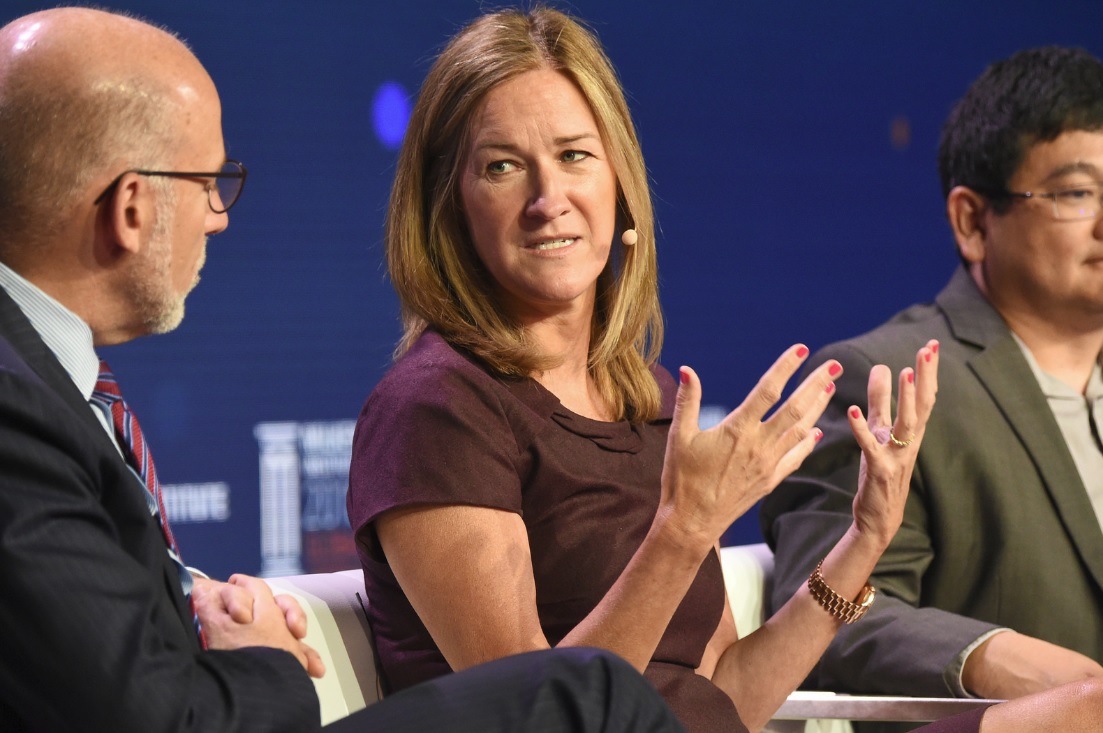
Above: Steve Cohen (left) of AEG, Ann Hand of Super League Gaming, and Dean Takahashi of GamesBeat.
Kent Wakeford: I’m one of the co-founders and owners of an esports organization, KSV. We own a number of esports teams around the world, teams located in China, Korea, and in Los Angeles. Our teams cover most of the major esports out there — Overwatch League, League of Legends, and a number of other games like PUBG, Heroes of the Storm, and so on.
Nate Nanzer: I’m the commissioner of the Overwatch League at Activision Blizzard. That’s all this stuff over here. Overwatch League is a global professional esports league based on the game Overwatch, made by Blizzard Entertainment. We have 12 city-based teams, of which Kent is one of the owners, the Seoul Dynasty, and Steve over here is one of the owners of the Los Angeles Valiant. City-based teams that play all their matches currently at the Blizzard Arena in Los Angeles, in Burbank Studios, but in the future we’ll be moving to full home and away, so when Kent and Steve’s teams play each other that team will get played in either Seoul or L.A.
Ramon Hermann: I currently work at Tencent, with a focus on mobile esports. I’ve been in the games industry for more than 15 years now. I remember the very humble beginnings of esports. One of the first events I helped organize, the audience could probably fit in this space three times over with room to spare. Nvidia was the title sponsor, by donating one graphics card. I think the whole budget was $40,000. We’ve come a long way since.
Ann Hand: I’m the CEO of Super League Gaming. Super League was founded about three years ago on the premise that with the explosion in esports at the professional level, it was inevitable that a little league and minor league system would emerge. Think of us as a way to harness the up and coming fanbase for professional esports, but also provide an aspirational path to the pros.
Steve Cohen: I wear multiple hats, but for our purposes here I’m chief strategy officer for AEG. We’re a worldwide entertainment company, primarily in sports and live entertainment. We have about 27,000 employees around the world and operate on five continents. We have the good fortune of being a stakeholder in Immortals, and because of that, we have a meaningful stake in the L.A. Valiant, which is part of the Overwatch League.
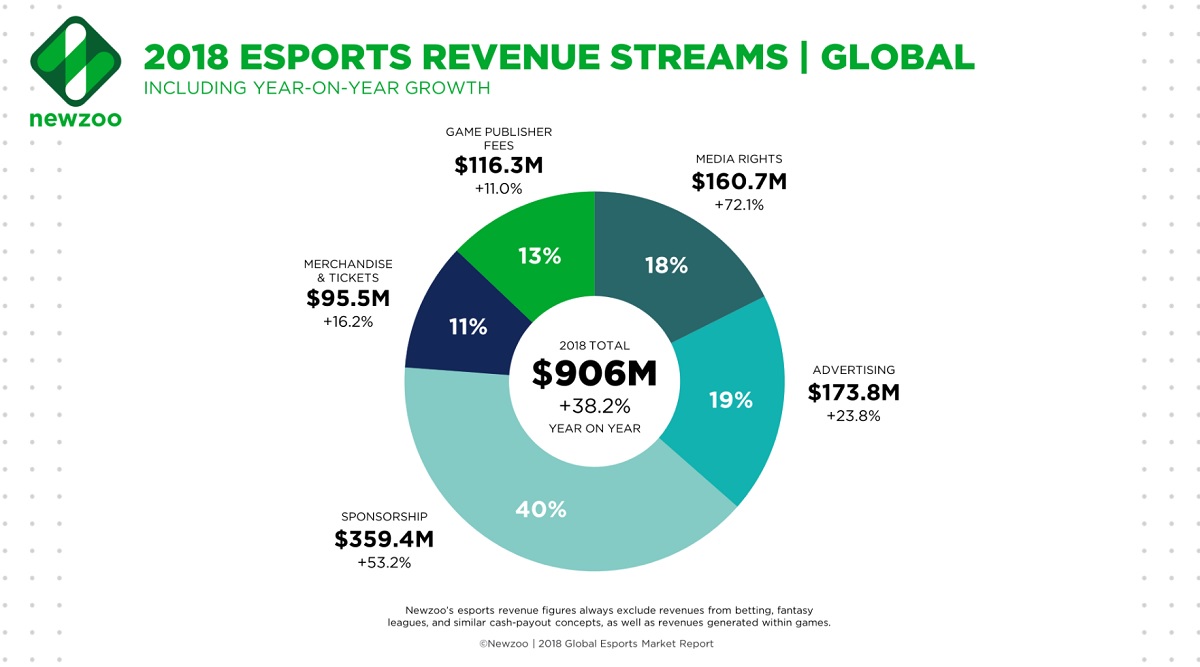
Above: Sponsorship is the biggest source of revenue for esports in 2018.
GamesBeat: Esports is expected to grow 38 percent to $906 million in 2018, according to Newzoo, and grow to $1.65 billion in 2021. Those are big numbers, but that’s actually less than one percent of the global gaming business, which is $138 billion in 2018, growing to $180 billion in 2021. You can think of that percentage as an opportunity, or as evidence of overhype. We’re talking about less than one percent of the game industry catching so much attention just in the past year. Kent, can you paint more of a picture of what kind of investment has been going on in esports? What are the layers of that investment?
Wakeford: One of the reasons why we’re all in this industry and in this sport together is a rapid increase of growth across multiple dimensions. Dean touched on revenue. Revenue growing 38 percent year over year in 2018, growing to estimates of $1.4 billion to $2.4 billion in 2020. That’s a lot of growth. More interesting is the audience size. The audience size for esports today is about 380 million people around the world, growing to about 550 million people in 2021.
To put that in perspective, the audience for esports in 2020 is expected to be greater than all other U.S. professional sports, with the exception of the NFL. That’s an interesting stat to keep in the back of your mind. Another is, there was a recent championship game played in League of Legends. That was held at the Bird’s Nest Olympic stadium in Beijing. It sold out the stadium in minutes, with 40,000 attendees. It had 60 million people watching. That’s second only to the Super Bowl, at 110 million plus.
Think about the size of this industry and the opportunity. You think about any other traditional professional sports from an investment perspective, the valuations that professional sports teams have, and there is a big white space of opportunity, which has led to a lot of capital flow into the esports space. It’s created a lot of opportunities for team owners, as well as the leagues and other game publishers. It’s a big reason why we invested, and why we continue to see more capital flowing into esports.
GamesBeat: Steve, there’s a lot of money flowing into venues, too, the places where these events are held?
Cohen: Just to riff on what was just mentioned, we’re all here in some part because of the effects of the law of numbers. That’s meaningful. I can regale you all with tales of multiple nights selling out at Mercedes-Benz in Shanghai, or in Hungary, or at Barclays, with esports events. That’s all very compelling, and it’s part of the reason we’re in the game.
But at its core, there’s also this element of the experiential. That, to us, is very important. That’s what creates the stickiness that we can drive in all sorts of directions, and make it compelling for our fanbase, for our sponsors, for our partners, for the people we collaborate with at all parts of the continuum on revenue scale. From that perspective, we’re very focused with our venues — whether they’re smaller venues in the 250-person category, or a full-blown arena or everything in between — on making sure there are customized elements that enhance the experience for everyone in the ecosystem.
That’s what’s going to make it something that amplifies the success of people that are doing it in their communities, more on a locally-based level, but it also affords the opportunity for integration and activation in a world where conventional advertising or sponsorship or whatever you want to call it has been completely disintermediated and is lacking credibility.
Nanzer: Something I’ll add, the Overwatch League — we were very thoughtful from the beginning about trying to create a league that would welcome investment. Esports, for a long time, in the old days Ramon mentioned where we had 30 people in a room on CRT monitors, a lot of that activity was grassroots, organic. The community was driving it. Publishers really viewed it as engagement marketing for games. It wasn’t viewed as a stand-alone business opportunity.
On the Overwatch League, we saw an opportunity with a new game, our first new IP in 17 years. It was an opportunity to build something from the beginning of a game’s life cycle. It was a game that was really well-suited to team sports, a 6v6 game. We saw, through events we do like BlizzCon, which is sort of the Super Bowl of Blizzard esports — it’s in Anaheim every November. We sell 25,000 tickets at $200 each in about six seconds, with 90,000 people in the queue trying to buy them. We see incredible engagement with our events. We know there’s something powerful about experiencing esports live.
In the way that I was never a soccer fan until I went to a Premier League game in London — I was like, “Oh, I get it now” — it’s the same with esports. It’s competition. It’s more fun to watch competition when you’re there and you’re connected to other fans and you have a shared experience. We saw an opportunity to bring that to more fans around the world by geo-locating the teams, and also opening up investment opportunities for people like Kent and Steve and others, to really bring them along as partners in building a league and making sure that the league is driving significant revenue for the teams, while the teams have opportunities to create new revenue streams.
We’ve been thoughtful about how we create an esports league that’s welcoming to investment. I think you’re seeing that more and more across the industry as well.
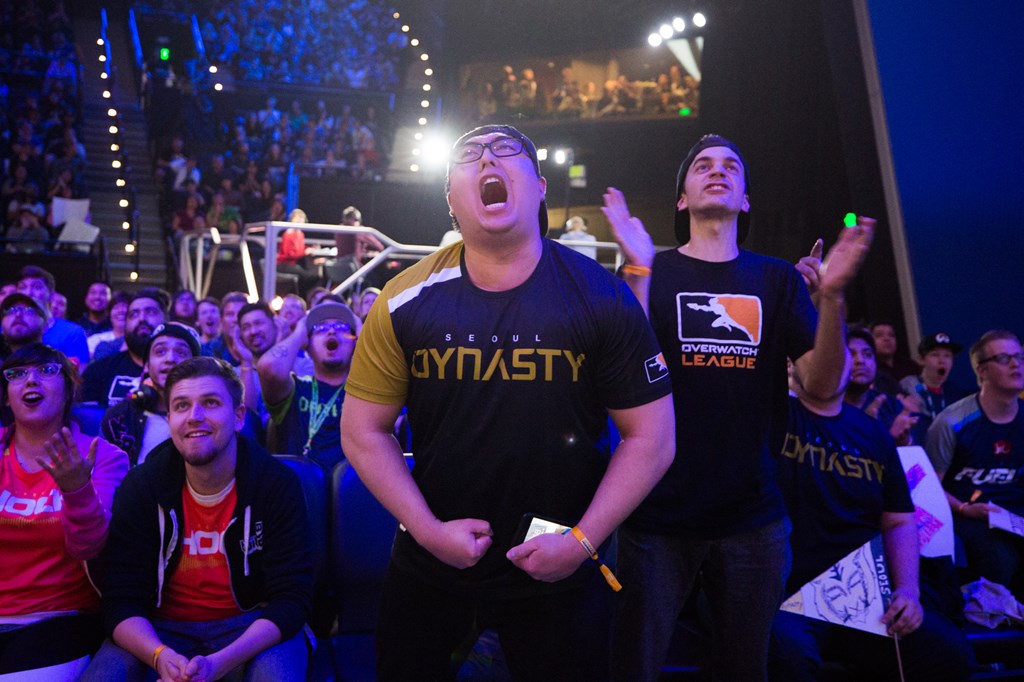
Above: A Seoul Dynasty fan cheers on his team in the Overwatch League
GamesBeat: We should point out that before this happened, the question was always there: “Why would anybody want to watch a video game when they could play it?” Then we had Twitch come along. Twitch is now well-known. About 150 million people watch live streams of people playing games and doing other things. That got established. It had to happen before something like the Overwatch League became possible.
Nanzer: That’s right. I’d also ask, of course, why anyone would ever watch golf. And the answer is, you watch golf because you’ve played golf, and there’s something about this activity — it’s only natural that you want to see who’s the best in the world at this thing you love to do. Esports is no different. More than 35 million people play Overwatch. It’s only natural that they want to see who’s the best in the world at this game that they spend so many hours of their lives playing.
Hand: Just to jump in a bit on the valuation and the infrastructure side, when I see the stat about this being a billion-dollar industry, not only does that show that the potential huge upside of the esports category, but it’s also really focused on the professional level. That’s like quantifying what baseball is worth locally and only talking about the value of the major leagues. To me, there’s a huge amount of growth and opportunity that isn’t being captured right now in those estimates.
As far as the investment side, what’s been fascinating for us as more of a mainstream esports play is the way we’ve attracted some non-traditional investors. For example, companies like Nickelodeon have invested in us, because we’re running youth leagues. Cinemark has invested in us because theaters are empty a lot. A movie theater makes for a pretty decent playing field for esports at an amateur level. It’s been interesting to see, to your point, that the numbers don’t lie. It’s attracting a lot of interesting attention.
To me, being at this for three years, I think this year is the year of infrastructure. This is the year that, through the work Overwatch has done with their league, and the same with League of Legends, through the venues’ role in this and the localization of esports — this seems to be the year where the focus is on making sure we have sustainable leagues and sustainable venues and locations to dig in and put down the stakes.
Cohen: One more quick observation, and it plays to the historical stereotypes of who would want to watch this. I think there are a lot of people in a certain generation, and I’ll pull myself into this category—their rudimentary understanding of the esports audience is it’s a 15- or 16-year-old acne-faced boy in a basement with a screen just playing. Nothing is further from the truth. It is intensely community-based. That’s an incredible opportunity on so many levels, not only commercial but otherwise.
People want to be together. They want to be together to play. They want to be together to watch and participate. That creates, for us, from an experiential basis with our venues, huge opportunities to deploy in totally different ways, different from some conventional sports. That’s another old tale that needs to be dispensed with in terms of what we’re dealing with today.
Hand: Absolutely. Super League has run about 2,000 events over the last couple of years. If I have any regrets, it’s the way that I spoke about our target demographic in the early days, because there was a subtext, or an apologetic tone to it. “Isn’t it great that we’re getting kids together?” Almost implying that they were a niche group that was disconnected and alone.
Having run that many events — and we also run adult events, 16 and over events — we got it all wrong. This is such a diverse psychographic of people. We have girls who game. This should be a gender-neutral sport. Gamers have higher graduation rates and household incomes than traditional sports fans. This is a very multifaceted, accomplished group.
The other big headline is that gaming is no longer something you grow out of. It’s a lifestyle decision. People will come in and out of different game titles. Sometimes they’re players and sometimes they’re spectators. But it’s time for us to debunk this idea we have about who a gamer is.
Wakeford: About spectators and viewership, a fun fact. Nate has done an amazing job as the commissioner of the Overwatch League, as you can see up here. Viewership for Overwatch League on Thursday nights surpasses that of the NBA on Thursday nights. Think about that for a second. We’re talking about a massive audience. Second, back into investment and capital—investment into esports in 2017 grew 1,125 percent year over year. A massive inflow of capital, and that’s just on the venture side.
GamesBeat: It felt like I wrote an esports story twice a week, usually about an investment.
Wakeford: The other areas of investment that don’t get reported as much, although they’re often buried in the headlines — it’s the investment from traditional sports moving into esports. It’s a tectonic shift that’s happening in the traditional sports industry. If you look at the viewership numbers for a number of traditional sports, they’re going down.
Nanzer: Especially with viewers under 35.
Wakeford: With the millennial group, there are more millennials watching esports than a number of traditional sports out there.
GamesBeat: We should mention some of these names. The Philadelphia 76ers have invested. Robert Kraft has invested.
Wakeford: Within the Overwatch League you have the Kraft family, the owners of the Patriots; the Kroenkes, the owners of the L.A. Rams; Fred Wilpon, owner of the New York Mets. That’s not to mention NBA2K, which now has about every NBA team adding an esports component to their organization. This is a major shift in terms of what we’ve thought about as traditional sports. It’s a change in the landscape, a paradigm shift that’s fueling this investment. It’s why you’re all here today, because it’s a radical shift in a massive industry, in the traditional sports industry.
Nanzer: We’re seeing the way fandom plays out, and it’s exactly the way you’d expect it to play out in traditional sports. We had this moment two weeks ago at the Blizzard Arena, where I feel like I saw that local esports is born. It was Steve’s team, the Valiant, playing Stan Kroenke’s team, the Gladiators. Just organically, half of the audience was purple and half of the audience was green. They’d self-selected which side of the arena they’d sit on. They were talking back and forth. It was amazing to see.
We’ve already seen viewing parties all across the country. The New York Excelsior, Wilpon’s team, already has a supporters club that came together organically and goes to a bar in Brooklyn for every single game to watch the matches. We’re really seeing the fandom manifesting in the same way it manifests in traditional sports. We’re hearing from young fans — who spend all their time watching other people play games on platforms like Twitch and YouTube, and are disengaging with traditional sports — that this is finally the New York or Los Angeles team for them.
Cohen: I would point out that while it is a radical movement in some ways, it’s not in others. Our Los Angeles Kings players, Galaxy players, Lakers players, they’re avid fans of esports. Zlatan Ibrahimovic has a Valiant jersey, I’ll tell you that right now. That’s important, because in these legacy sports — which have their own authentic credibility with their fanbase — the players within these sports themselves have incredible credibility. They’re competitors. They work hard. They’re elite at what they do. When they like something, their fanbase associates with it.
Part of what we’re creating here, and what the Overwatch League is an example of, is a different kind of credibility and authenticity. Then you’re not a Trojan horse anymore. You’re part of the family, and when you’re part of the family you can introduce yourself in all sorts of ways and have different dialogues with your fanbase than you can if you’re just a commoditized product.
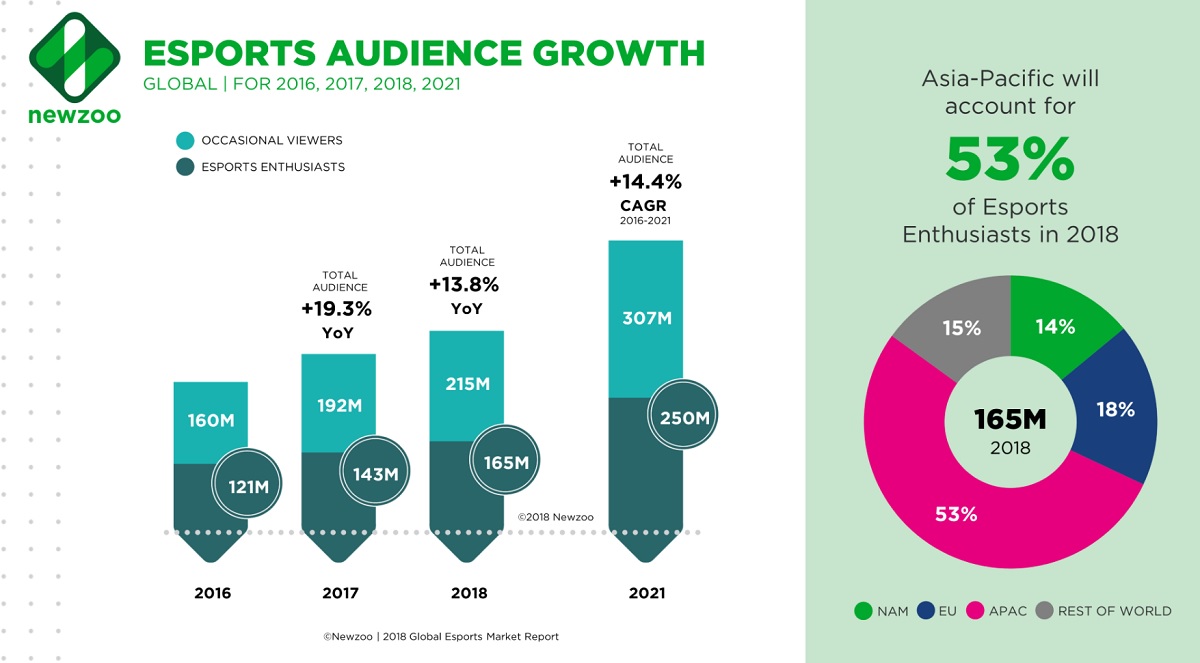
Above: Newzoo expects the total esports audience to grow to 557 million in 2021.
GamesBeat: Yesterday Steve Ballmer was sitting in this slot. In 2014 he bought the L.A. Clippers for $2 billion. We’ve done a good job getting people excited about the opportunity here, but we should flip the coin and talk about some of the challenges as well. One of them is — Dennis Fong, who was at our GamesBeat conference earlier this year, was one of the first star competitive gamers. He won John Carmack’s Ferrari as the world’s best Quake player 20 years ago. He said that nobody is making money in esports. That’s a little detail we may have left out so far.
Comparisons to traditional sports happen a lot. Newzoo points out that the average esports fan right now spends about $4.58. The NBA basketball fan spends at least three times more. These raw numbers may not sound right, but ratio is correct. In a given year NBA fans are going to spend a lot more money on their fandom. They’re more passionate, at least, about tying their wallet to what they’re interested in, compared to esports fans. That’s part of the challenge for esports.
What has to happen? What parts of the business model still have to mature?
Cohen: Just a couple of quick comments. First of all, I don’t think that statement is generally right. From an event-based perspective, I can tell you that plenty of folks in the ecosystem are making money. When you sell out three days at a stadium for a final, lots of people are making money.
When you start talking about leagues and about ARPPU — yes, on ARPPU there’s room for improvement. But this is all new. The leagues are new. Right now the critical thing is building the proper infrastructure from the ground up to make sure this is sustainable for the long term. You’ll have to make some investment on the front end to allow that system to prevail and thrive in the long term. If there’s an expectation that you’ll be making big money in a new league on day one, then you have your own problems. You’re in the wrong place for your investment.
Hermann: To add to that, I’d like to zoom out one or two steps, because typically what happens when you talk about esports is you focus on the top-tier competition, the tier-one leagues that are currently active. But for any ecosystem to thrive and be sustainable, you have to look at what happens beneath those top levels. These are some of the things Ann touched on earlier. What does a little league look like? How do people grow into that space? Where do future athletes come from? How do they start acquiring their specific preferences? How do we grow fandom?
One of the areas I was pleased to work on while I was at Riot Games was the collegiate space. College is such a great blueprint for how sports can work, especially in the U.S. ecosystem. You already have all these different things in place. Esports fits into that narrative perfectly. Riot built out a club program that built out to something like 800 college clubs. I believe Blizzard has a similar program in place running leagues in that space. Scholarships are paid out to students. But more interestingly, colleges are starting to set up scholarships on their own to attract students to join their competitive teams and participate in those leagues.
One of the most exciting projects for me to work on was getting the Big Ten conference on board to run the full season for 12 of their 14 member schools and have them compete. It was an interesting experience, flying out to Chicago to talk to the commissioners of their sports groups and getting them to understand what’s happening on their campuses, what students are doing these days.
If it wasn’t for the fact that I’m working in the space, I’d probably have 15- and 16-year-olds calling me out about everything I’m not doing right and not understanding. I would have a huge disconnect with that space. But it became apparent when I was talking to some of the existing people who work in traditional sports, the last time they played a computer game might have been the ‘80s, in the heyday of Pac-Man or something. There’s a lot of education that still needs to happen to go there.
GamesBeat: One very interesting fact for the parents in the room is that Riot is sending 500 students to college on League of Legends scholarships right now. What does that do to your advice for your kids about whether to study or play video games?
Hand: There’s something about League of Legends as a game, and Overwatch has a lot of these attributes as well. There are deep layers of strategy and critical thinking. It’s not just that these esports scholarships necessarily mean those people are going to become professional players. But it says an awful lot about that person’s cognitive potential and a whole range of career options that are available. It’s quite a good metric for the brainpower of that individual.
Nanzer: We have a group we work with at Blizzard called Tespa. It’s our collegiate esports. Across all the chapters — I think we have 400 or so chapters across the country — almost two-thirds of the people that participate are STEM majors.
Hand: One of the more popular conversations we’ve been having with both publishers and professional teams, which are really our two most important stakeholders as the amateur league system underneath — there’s a very popular conversation about the under-18 market. In addition to our youth leagues, we’re starting to run high school league competitions as well. That matters to the pro teams, because finding you around 16-18 is important to them.
Of course Tom Brady is a quarterback at 40, and the life of a professional esports athlete will extend as well, but right now it tends to be that the heart of their career is in the 20-24 range. Also, as I alluded to earlier, the kid who plays little league is going to be a baseball fan for life. The importance of introducing the future esports fan is important as well.
When you get to the game publishers–once you join a league you participate in a sport in a different way. I always jokingly say that I played tennis growing up, and I could have learned to play hitting a ball against the garage door, but something different happened when I joined a team, the stickiness I built around that sport. There’s also character-building and teamwork and all those other good attributes. When you’re trying to get people to introduce each other to game titles and to esports and get them to stay with that sport for a long time, sometimes being part of a league and a team is a good way to do that.
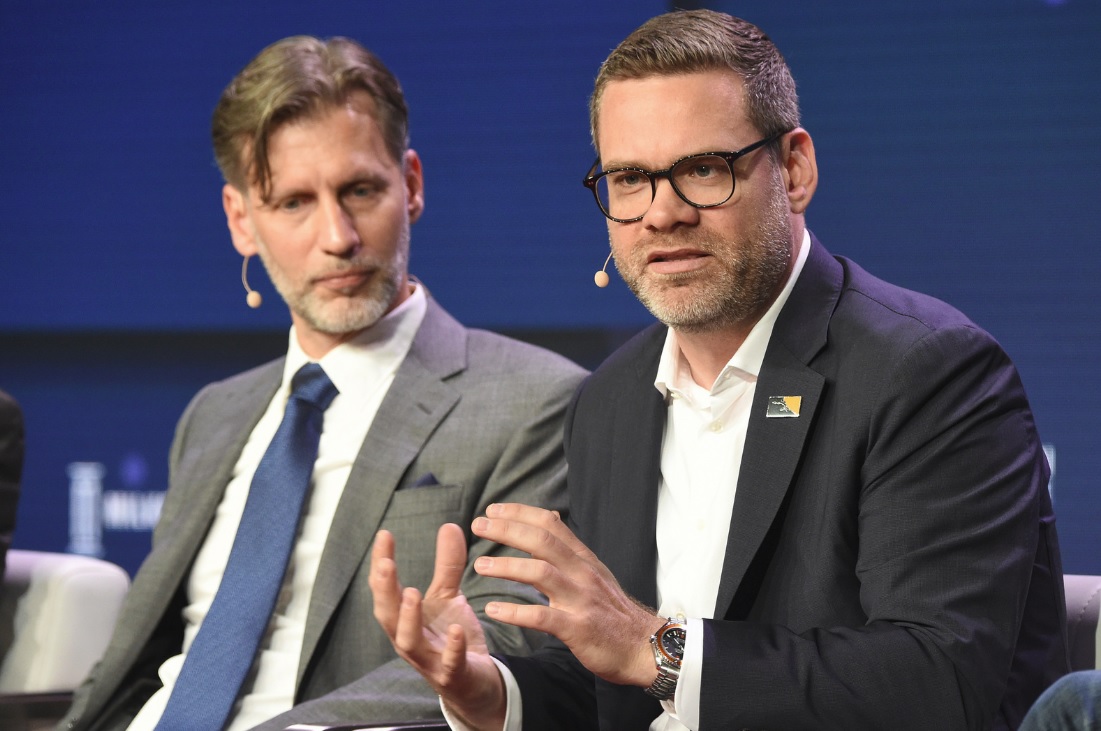
Above: Ramon Hermann (left) of Tencent America and Nate Nanzer of Overwatch League.
Wakeford: We’re seeing the evolution of—there’s now esports organizations across high school. There’s collegiate esports. And at the professional level, the professionalism and the compensation have become very real. Nate, you’ve done a good job with the Overwatch League setting minimum requirements. We have salaries that are in the hundreds of thousands to millions of dollars for esports players. Health benefits, 401k, all the types of benefits you’d associate with professional players.
Just to put this in perspective, within the leagues we play in, there’s a player we compete against, Faker, and he’s reportedly making more than $5 million a year. This is not just kids in basements playing. There are real career paths. And this is just the start.
Nanzer: Part of it is, in addition to the incredible focus and cognitive ability you have to have to play these games — we had a video running over there, one of the matches, and there’s a player named Birdring. I promise you, not a single person in this room is physically capable of doing what he does. You could spend the next year doing nothing but playing Overwatch and you would still—he could close his eyes and destroy you. The reaction time, the ability to move a cursor a precise point in fractions of a second — there’s a physical component to this, and these players work incredibly hard. They spend a lot of time practicing.
But I think one of the other things that speaks to the professionalization of esports—in the Overwatch League we have multiple teams that don’t just have coaches. They have performance coaches. They have chefs. They have nutritionists. They have team psychologists that work with the players. There’s a ton of infrastructure around the pro players to help them succeed. The teams in esports that are the most successful are the teams that invest in the resources around the players and treat them like the professional athletes that they are.
Hand: If there’s anything, for any of you new to esports, that we can debunk here today–it’s no different than traditional sports. The difference between what makes a good and a great athlete is all the additional dimensions of commitment, hard work, practice, being coachable, being a good team player. It’s all of those extra layers. The emotional intelligence, the resilience. These things can only happen through the structure of these great professional leagues and all the other resources and support they put around these people to push them to reach their maximum potential.
GamesBeat: Here’s a rapid-fire question for each of you. How do you decide what a great venue is going to be? How do you build local affinity for esports? How is mobile esports going to take off? How do you spin up a league where you do have local affinities going on? And how do you spin up a team?
Cohen: The optimal venue is a multi-variable equation. It’s going to depend on the type of game, the expectation of how large the crowd is going to be, where you are geographically – what plays well in Berlin is different than what plays well in Stockholm is different than what plays well in Los Angeles. Start with that, with an understanding of what you’re presenting to the world and what the fanbase is and how many people you expect to be there.
Then you get into the logistics and the technology of how you deliver it in a way that’s immersive. That’s incredibly important for us, because the experience is intensely enhanced if people feel that they’re truly in the game. If it’s just going to be one-dimensional, just looking forward, there isn’t sound, there isn’t a touch and feel that makes you feel like you’re part of everything, that’s going to backfire on you. You’re not going to get these same people to talk to their friends and come back themselves again.
By way of example, for Immortals, and particularly for the L.A. Valiant, it’s not that the Microsoft Theater is their home venue. The entirety of L.A. Live is their home venue. We’ll do things in 200-seaters, in 500-seaters, in 1,000-seaters, in 4,000-seaters, and 18,000-seaters. It’ll all depend on what we’re doing and who’s there. Is it a practice session, where we have some of the Lakers or the Kings involved? Or is it a grand finale where we’re competing against one of the best teams in the world?
Hand: How do you build local affinity? We spotted an insight a few years ago, very similar to the guys at Activision Blizzard with the Overwatch League, which was that there was a lack of locality to gaming. It was hyper-fragmented. Gamers had a desire to self-identify. So we introduced, for our amateur league system, city-based teams and clubs.
For us, what’s unique about that is this is the unifying umbrella for all of our game titles. Whether it’s 6-to-14-year-olds playing in our youth league around Minecraft, or 16-30-year-olds playing around League of Legends and other titles we’re introducing soon, everyone who plays in L.A. is a member of the L.A. Shockwaves. We have a member of the Shockwaves right there, because I see Monkeyman in the front row.
It’s important, in a way — again, I feel like this was a bit of a moment that was a breakthrough for us. In the early days, we thought we couldn’t possibly have a 30-year-old identifying to a brand called the Shockwaves, and having a cute little fresh-faced 10-year-old with their parents identifying to that same brand. There’s this edginess to some of the older game titles that you can’t mix with the apple pie of Minecraft. But what we realized through the city clubs was that actually, that’s the beautiful, positive, unifying umbrella.
I always overuse the analogy, but now, when I have one of my hardcore League of Legends players walking down the street — he’s 28. He’s wearing his Shockwaves jersey. He passes Monkeyman there. He just thinks he’s Kobe Bryant and you’re a Lakers fan. It works. But in a really neat way, I think it flips the problem on its head. It allows two very different demographics to identify with each other, to spot the one thing they have in common, which is a love of gaming. And in a strange way, it turns it into a bit of a mentor-mentee relationship.
The younger Overwatch players probably played Minecraft as well. It’s a very natural way to start to identify and show the path and progression that people make from the earliest games, which get them positively engaged in gaming, through to games that we can start to create new features for.
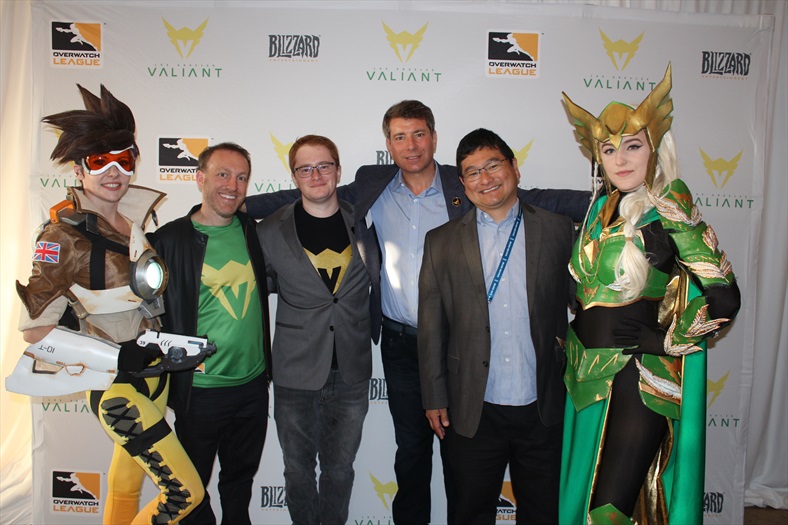
Above: Lionsgate’s esports reception.
Hermann: On mobile esports, I strongly believe that mobile is the new frontier for esports. PC and console aren’t going away any time soon. They’re seeing steady growth. But if you look at the numbers, mobile is outpacing that growth.
If you look at the younger generation, a lot of kids growing up today may not even have a PC anymore. They may not invest in a console. Technology has come such a long way that the kind of games you can play on mobile today are starting to compete with what’s happening on more traditional platforms.
If you look at countries that don’t have a strong history of PC or console gaming, especially in Asia — China is huge when it comes to mobile. Tencent’s most successful game in China, Honor of Kings, has about 200 million active monthly players. The numbers are enormous. Tencent has just started to set up a league along a very similar structure to Overwatch that’s franchised in China. It’s just a matter of time until we hit that critical mass in the west.
I don’t know how long it’s going to take. We’re just trying to explore how it’s going to work here. It might be a bit slower than what we’ve seen in Asia, but I’m convinced that it’s going to happen.
GamesBeat: A lesser-known fact is that mobile gaming is now half of all gaming revenue, $70 billion out of $138.
Nanzer: How do you start a league? It’s super easy. [laughs] I get to do panels and talks like this all the time, and I get way too much credit for launching the league. Overwatch League is countless hours of work from a huge team across the entire organization.
One of the most important pieces of the puzzle was getting great team owners. Franchising the Overwatch League, we wanted to make sure first and foremost that we had great operators. Running an esports team is not an investment. It’s not a thing you’re going to put money in and get money out. It’s like a sports team. You need to operate it.
We wanted to make sure had world-class operators to help us launch the league and do that together. We’re not going to be able to build fandom in New York and Boston and Seoul and Shanghai unless we have great team owners that are going to be investing and growing in those markets. What it really took to launch the Overwatch League was getting the structure right, making sure we had a structure that was attractive to outside investment, a structure that was going to really be one that’s oriented around value creation for all the stakeholders involved.
From an operations perspective, we built a team around the Overwatch League that’s able to learn from Blizzard’s 20-year history in esports. The original StarCraft, to a lot of people, is the first esport, a game that came out in 1998. We have two decades of learning about how to operate esports event from a very tactical standpoint. But we’ve also build a team around the Overwatch League with a lot of folks from traditional sports and media. We have folks on our team from the NBA, from Fox Sports, places like that. The combination of everything we know about gaming and esports and esports communities with best-in-class operators at the team level, from traditional sports and media and within our team, that part of our special sauce around the Overwatch League.
GamesBeat: There’s a tougher question for you, which is, what happens when the Fortnite league comes along and steals part of your audience?
Nanzer: First part of your question, what happens when the Fortnite league comes along? That’s cool. I like Fortnite. Second part of your question I disagree with. I don’t think esports is a zero-sum game. There’s a tremendous amount of audience out there. You see this play out now. Go to Twitch on Saturday and you have 150,000 to 200,000 people watching Overwatch and League of Legends and Ninja playing Fortnite. Over the next few years we’ll end up with the tier one esports — the NBA, NFL, MLB, and NHL — but there’s also going to be a tranche below that with dozens of games that all have hardcore dedicated audiences, even if they’re maybe not on the same scale. They’ll still have thriving esports scenes.
We’re still at the phase in esports development where a rising tide lifts all boats. There’s still a lot of work to do as an industry, but overall we’re in a good spot. The work that folks like Anne are doing at Super League Gaming—the thing that’s exciting to me, I have a son who’s about to turn eight. He plays Roblox now. But him and all of his friends — I look at the Blizzard Arena every Friday and Saturday, where we have tons of 12- and 13- and 14-year-olds there — these kids are not going to magically start watching football when they turn 25. They’re not going to turn 30 and say, “Well, now I’m gonna watch TV.”
These kids are growing up watching Overwatch, League of Legends, and Vainglory. They’ll be fans for life, in the same way that I, for some reason, am still a San Diego Padres fan. My dad made me watch the Padres. That’s stuck with me my whole life. That’s the big shift that’s happening right now. Through Twitch and YouTube and everything in China and all these different platforms, this is what kids watch today.
It’s premium content. That’s the thing people miss. They think, “Oh, it’s that Ninja thing,” a guy in his house playing video games. No. It’s premium content. I promise you that the guy in the front row there thinks this is significantly more premium than anything on ABC, CBS, or NBC. That’s not going to change.
GamesBeat: The traditional entertainment leaders were on stage yesterday. I think the thing that scares them is that millennials are not watching TV, right? Where are they going? Where are they watching things? It’s online and it’s esports. The fact that the traditional sports owners are coming in, in some ways they’re reading the writing on the wall. They may be facing a declining future.
Cohen: One quick element of what I also think has been part of the true success of the Overwatch League. We’re in a number of traditional sports leagues — NBA, NHL — and we were there at the beginning of MLS. We’ve ridden that to where it is today. The big differentiator in one respect between legacy sports and things like esports, you now have, in the hands of the publishers — they quite literally own the sport.
To successfully build a league, the most critical thing is to create an alignment of incentives with those people that are coming in to invest in teams. If the feeling is that someone can steal the rug out from under you and say, “It’s my ball. I’m going home,” we’re not going to extend ourselves to build it out. That’s been a terrific job that Activision Blizzard has done in the regard for folks like us who’ve come into the game.
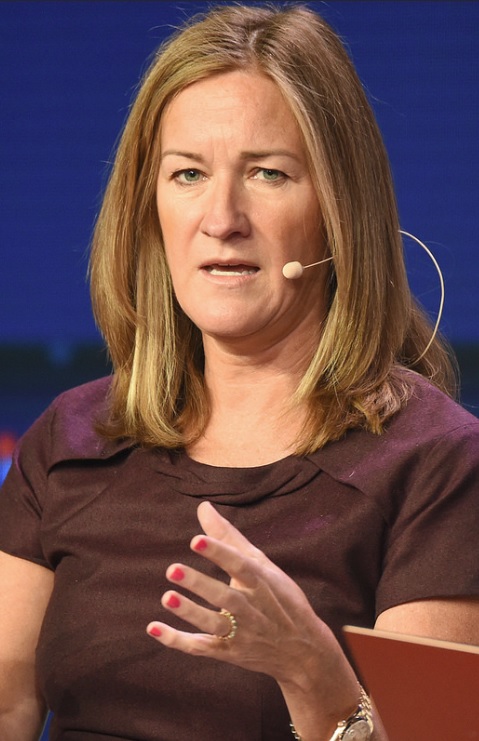
Above: Ann Hand, CEO of Super League Gaming.
Wakeford: So, building teams. It’s a commitment. It’s a commitment of capital, of resources, and of time. If you think about building teams, if you want to have a framework by which you can look at it and think about it, when am I going to invest? Where am I going to put my capital and my resources?
We have a relatively simple framework we use, a kind of three-pronged framework. First, we look at the game. Is the game conducive to an esport? Is it conducive to aggregating a large audience? Is it conducive to longevity, so you can play for a long time? These are all questions that investors often ask.
You’re seeing popularity around games. We mentioned a game called Fortnite, which is shooting through the roof. It’s relatively new, but it’s seeing rocketship growth and a lot of excitement behind it. Obviously esports owners are looking at it. But the other thing is longevity. This a question I hear all the time. Why are you investing in esports? It’s not like the NBA that’s been around for a long time. If the game goes away next year, do you just start another team? How does that work? You have to look at the core esports games that are out there. DOTA. Counter-Strike. League of Legends. These games have been in the market for more than 10 years and they’re still growing. You want to look at those hallmarks.
The next element is the league structure, the operations, and the tournament infrastructure. If I do have a team, where are they going to play? Are they playing in tournaments, in individual games? You want to see if there’s the potential for healthy league infrastructure. And then I would say what’s most important for us as a team ownership group, and I’ve heard this echoed many times, is franchises.
The ability to go in and, even if it’s a much higher capital expenditure — what we’ve done with the Overwatch League or with others is we’re writing a very big check, but we’re securing rights for something in perpetuity. With the Overwatch League we own Seoul for our team. With others you have an exclusive franchise or number of franchises.
That allows you, as a team owner, to make long-term investments. Invest in the teams, the coaches. You can also bring on partners. Obviously this is driven by sponsors and by streaming rights and other things, similar to what you see in traditional sports leagues. We need to be able to make long-term commitments so we can create long-term revenue streams. Also, on the fan side, we can build long-term relationships with fans.
If there’s a game that has all the hallmarks of being a great esports, and there’s a franchise opportunity for us, we’re definitely look at it. Those are the first two prongs. The third is, can we build a competitive team? Can we build a championship team that goes out there and can play? In our business we focus on Asia, bringing Asian esports players to a global stage. We have the advantage of some games to bring champion players west. But that’s not true for all games. PC adoption far outpaced console adoption in parts of Asia. When you get to console-based games, we don’t have as healthy a pool of players to draw from.
For us, it’s the game, the franchise opportunity, and then if we can pull together a great team that competes at the highest echelon. That’s how we think about team-building.
Audience: How would you suggest that companies looking to sponsor and form partnerships in the esports world interact with teams, leagues, and other organizations?
Nanzer: The keyboard, the mouse, the headset, this is the bat, the glove, the basketball shoes of esports. This is performance equipment. Every player has their preference around that. It’s always been amazing to me that we haven’t yet gotten to the point – I think we’ll get there very soon – Kent has a very famous player on his team named Ryujehong. There should be a Ryujehong pro model mouse that I can go buy. If I’m a kid and I look up to him, I want to use the same gear my favorite pro player uses. I should be able to go buy the mouse.
I think we’re going to rapidly get there, both through folks doing deals with individual teams and individual teams, and at the league level. Something that Steve touched on — we own the ball. From a publisher perspective, a league perspective, that you can’t do in traditional sports. You couldn’t go do a basketball shoe deal for every player in the NBA. We can do things like that in esports. The players are going to start to become stars. They already are for those of us in the community, but they’re going to start to break out. That’s where you’re going to start to see–in the same way I can go buy Kyrie Irving’s shoe, I want to go buy Ryujehong’s mouse.
Hand: We just, a few weeks ago, announced a multi-year partnership with Logitech. What we hold in common at the highest brand mission point of view with their CEO and their head of gaming business is this belief that there should emerge a legitimate path to the pros. We think that one of the best ways to identify who a competitive gamer is — we have 2.6 billion gamers in the world. How many of those people identify as competitive? Well, it probably means you’ve invested in your peripherals. We think that’s a common way to hone in on who that audience is and how to start to provide different experiences for them.
Audience: How is the ecosystem incentivized to work together? Can you give us an update on Overwatch in that regard? Also, there’s a fear that publishers are going to be able to own most of the profits in this business. Obviously you can’t operate without permission from Blizzard and other publishers.
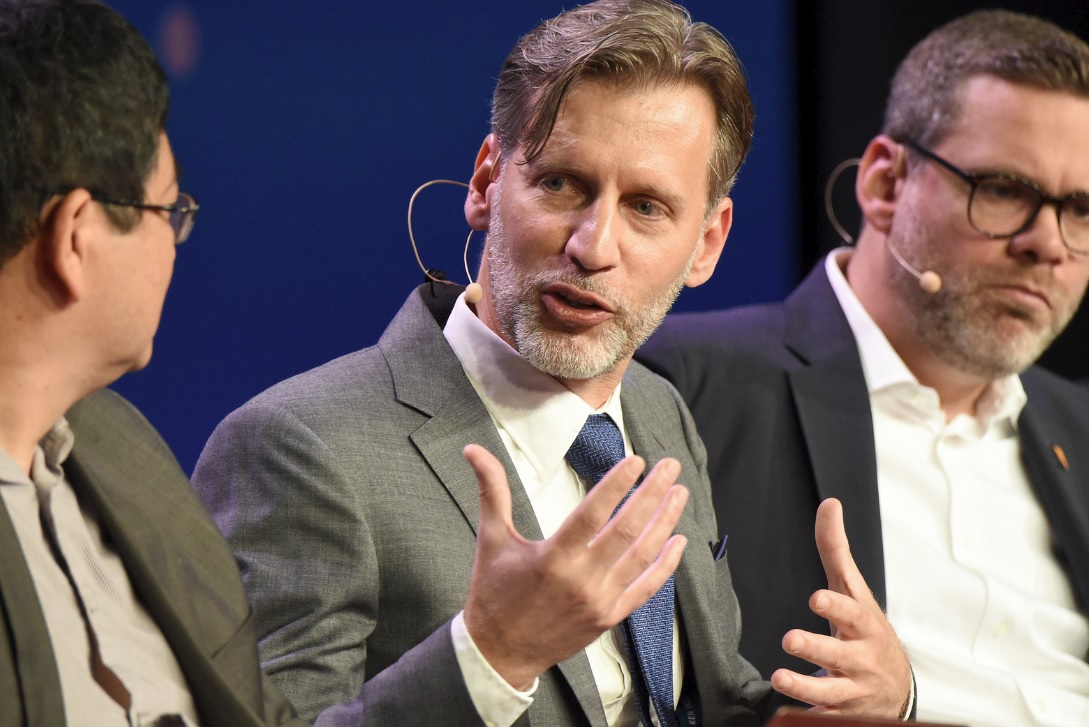
Above: Dean Takahashi (left) of VentureBeat, Ramon Hermann of Tencent America, and Nate Nanzer of Overwatch League.
Nanzer: From our perspective, it’s important to set up a clear path to pro. There’s a team on my team that’s called the “path to pro” team. When you think about that ecosystem, it all starts in the game client, people playing Overwatch at home in competitive play. We want to make sure we give people a jumping-off point. If you decide, “I’m going to get good, I’m going to take the next step,” you know the steps you need to take to be a pro gamer. We’re trying to talk about how to set that up.
From an ecosystem perspective, we still work with third parties. We do events. There are hundreds of Overwatch events happening around the world that most people don’t know about. Things like a small four-team tournament in Belgium that takes place during a game conference. We view anyone who’s participating in competitive Overwatch at any level — we think that’s a future fan of the Overwatch League, a future core fan. We want to do everything we can from an ecosystem perspective to incentivize players to take the next step, play in the open division in the game client, get good enough, and make it to Overwatch Contenders, our regional minor leagues that we run in seven or eight regions around the world. If you get good enough, you can get signed by one of the Overwatch League teams.
I think we’ve done a good job so far of incentivizing players to participate. There’s prizing at all levels. It ramps up the higher you get up the ladder. We can’t expect someone to work a full-time job and also have enough time to become a pro gamer. Many of our Overwatch League teams also have academy teams, where they have players who aren’t old enough to be on the Overwatch League team or players they’re developing.
We think we’re in the first pitch of the first inning in terms of developing that ecosystem, but down the road, all the opportunity you see in football, basketball, baseball, soccer, it’s going to exist not just in esports broadly, but in all esports generally. Esports is not a sport. Overwatch is a sport. League of Legends is a sport. Hearthstone is a sport. All of the individual games are sports.
Hand: Obviously, with publishers, they want to get more people playing their games and get them playing longer. Microsoft owns Minecraft. We’ve wrapped a kind of competitive team layer around it. It’s not a natural esport, obviously. But in doing so, we’ve created a premium experience that gets people to play the game longer and in a different, more heightened, competitive way. We were very careful with that brand out of the gate, because we knew Microsoft would come knocking. It was January 7, 2016 when I got a cease and desist letter from them.
We give out scholarships around tournaments. We make it about positive, inclusive gameplay. When it came to Riot with League of Legends, we again had to prove that we were adding a premium experience. The ranked players, their power users, were calling for their version of the LCS. “If you want me to keep investing the hours I’m investing online, I want a new way to participate.”
But another interesting stat, we just ran an event on Saturday for the TriBeCa Film Festival. It was a borough-versus-borough competition. The New York Excelsior guys came out, which is great. About 20 percent of the participants for League of Legends were women. That’s pretty significant. That’s a game that classically, because of the anonymity online, has a lot of toxicity. I think a lot of times the publishers see us, and rightfully so, as another extension of their local marketing arm, introducing new audiences and creating a way for them to play the game in a more accessible environment.
Audience: How do you see marketers fitting into this landscape? When it comes to brands and advertising, how do you find the right approach? You also mention toxicity. Some brands might not want to be associated with certain games. I’d love to hear more about your experience and best practices.
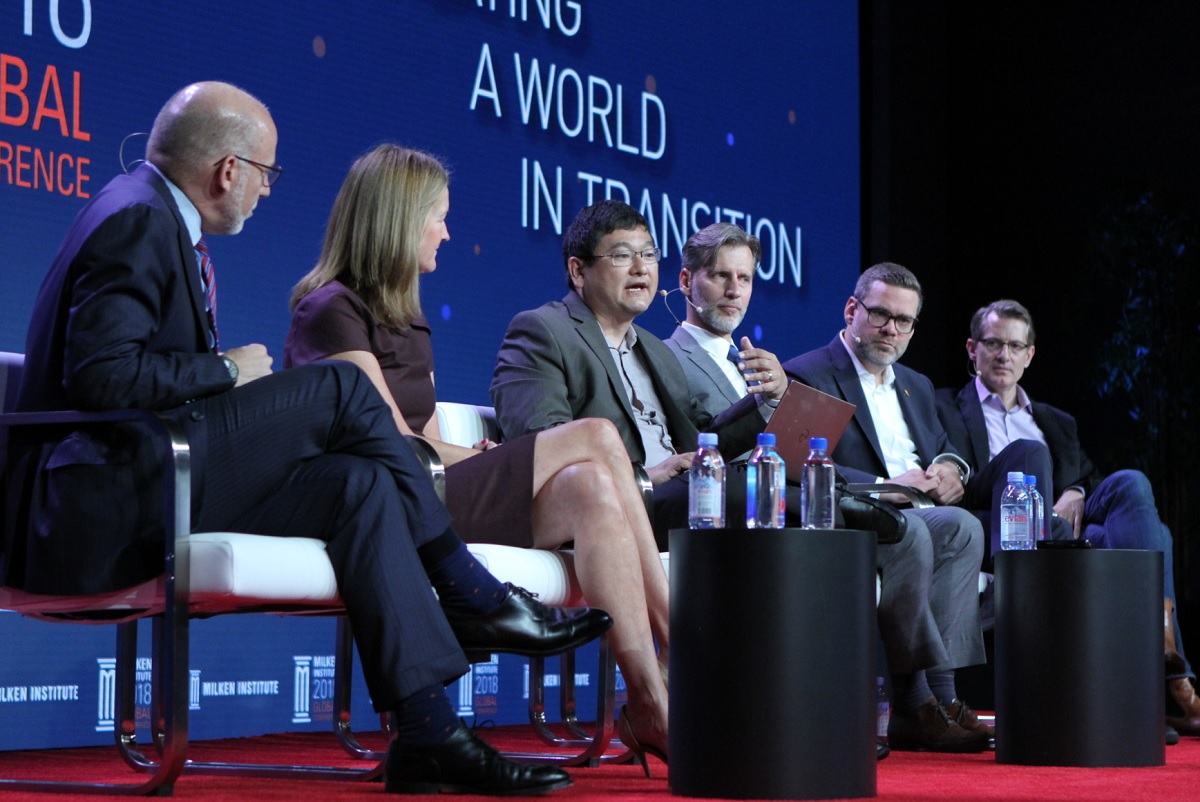
Above: Esports panel at Milken event, left to right: Steve Cohen of AEG, Ann Hand of Super League Gaming, Dean Takahashi of GamesBeat, Ramon Herrera of Tencent, Nate Nanzer of Overwatch League, and Kent Wakeford of Gen.G.
Hand: The nice thing about our mainstream, everyday competitive gamer approach is it does allow a lot of non-endemics that have been sitting on the edge — they want to get closer to gamers, but they don’t know how. It’s a safe entry point. Hence our relationship with Mattel and Hot Wheels, and I mentioned Nickelodeon earlier.
We hope that what we’re doing is creating that first entry point that dips their toe into the water as far as esports, and then they find a natural way to grow into the professional level, which is more unknown to them. I had dinner last night with the head of Nestle North America, talking about the ways we can bring some of their brands in. I hope we’re doing something good by giving a counterweight opportunity for brands that are on the edge.
Wakeford: When we think about the audience for esports, a large part of it is this millennial audience. It’s a huge audience. When you think about their entertainment consumption habits, they’re very fragmented. They use ad blockers. They watch things on their phone. They’re always on social media. It’s a hard demographic to go after. But it’s a very lucrative and important demographic for many major brands out there.
Now you have esports. You have what they play, what they watch, and what they talk about. You have the ability to be part of their life and their experience. Esports becomes this gateway to tapping into a very key demographic. What you’re starting to see is major brands moving into the esports market. It’s a consistent and regular movement.
It’s challenging, because if you come in at the team level, you talk to me. If you come in at the league level, you talk to Nate. If you come in thinking more globally, maybe you talk to Tencent. Where do you enter? What do you want to achieve? Each one of us offers something slightly different that may or may not be compelling to a certain brand.
Nanzer: The way that brands activate — I’m biased, obviously, but I think the sponsors we have are doing it the best. We’re not slapping logos on a broadcast. We’re creating branded content that’s additive for our fans. If you go to overwatchleague.com, you can watch Access Granted brought to you by Toyota. You can watch Turning Point brought to you by Sour Patch Kids. You can watch Game/Set brought to you by HP. This is all compelling content that our fans love and that adds to their experience.
For the brands, it’s the best possible activation, because they get in front of our audience in an authentic way. They’re attributed with creating this content that makes the experience as an Overwatch League fan even better. That’s how we’ve been focusing on bringing brands in, really sitting down with the brand, understanding their objectives, and figuring out a way we can activate authentically and create content for our fans that improves their overall experience and results in a great experience for the brand.
Disclosure: The Milken Institute paid for my accommodations at the Milken Global conference. Our coverage remains objective.
